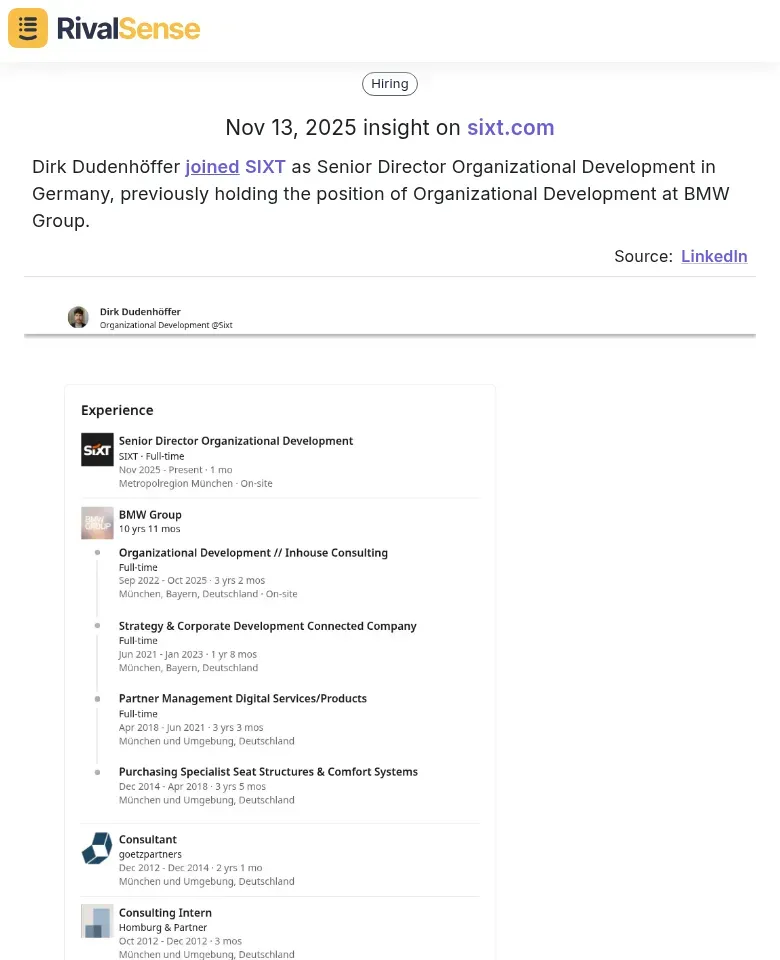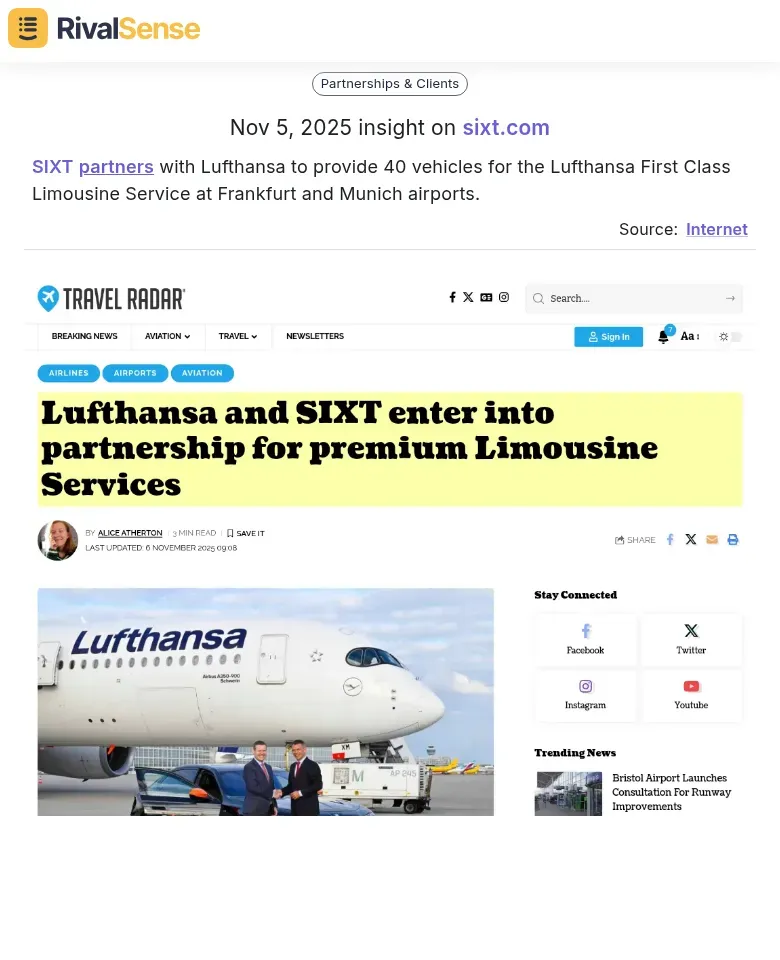How to Monitor Competitor Partnerships in Mobility Services
In the fast-paced mobility services sector, keeping an eye on competitor partnerships is essential for maintaining a competitive edge. These alliances—whether they involve corporate collaborations, talent acquisitions, or operational integrations—can significantly alter market dynamics and customer loyalty. For example, a ride-sharing company partnering with an airline can tap into a new user base, while an e-scooter firm acquiring a tech startup might enhance its app functionality overnight. To monitor effectively, begin by identifying your key competitors and tracking their recent activities. Utilize tools like RivalSense to scan announcements, press releases, and social media for clues about new partnerships. Focus on alliances that address service gaps or enable entry into untapped markets. Here's a practical tip: Create a weekly checklist to log new collaborations, evaluate their potential impact on your business, and adjust your strategies proactively. This approach helps you anticipate market shifts and respond swiftly.
Analyzing Talent Moves and Organizational Shifts
Tracking talent movements in mobility services offers a window into your competitors' strategic priorities and future directions. When rivals hire experts from industry leaders like Tesla or Uber, it often signals a push into areas such as autonomous driving, electric vehicle infrastructure, or ride-hailing expansions. For instance, a competitor recruiting a battery specialist from a top EV manufacturer might be gearing up for an electric vehicle initiative. To act on these insights, monitor platforms like LinkedIn and job boards for key roles such as CTO or product heads, analyze the backgrounds of new hires to identify skill gaps being filled, and note if talent is coming from adjacent sectors like tech, which could indicate diversification efforts. Organizational changes, such as the creation of new divisions for 'urban air mobility,' can also predict market entries. Use these clues to anticipate innovations and refine your own strategy—for example, if a rival builds a team for drone deliveries, consider how to position your offerings.
🔍 Example Insight: RivalSense detected that Dirk Dudenhöffer joined SIXT as Senior Director Organizational Development in Germany, having previously held a similar role at BMW Group. This type of talent move insight is valuable because it reveals a competitor's focus on organizational growth and expertise transfer, which can inform your own hiring and development strategies.

✅ Checklist for Tracking Talent Moves:
- Monitor leadership changes and key hires weekly
- Map new roles to specific business units or initiatives
- Correlate talent acquisitions with partnership announcements for a holistic view
Tracking Corporate Alliances and Service Integrations
Corporate alliances and service integrations are powerful indicators of how competitors are expanding their mobility ecosystems to capture more market share. By monitoring partnerships with entities like airlines, hotels, or other ride-sharing services, you can uncover efforts to create seamless, bundled travel experiences that boost customer convenience and loyalty. For instance, Uber's integration with United Airlines for airport transfers makes it harder for users to switch to alternatives. To stay informed, use automated tools like RivalSense to track partnership announcements and integration updates. Analyze the scale of these alliances—are they local, regional, or global?—and evaluate their scope, such as whether they cover booking, payments, or loyalty programs. Assessing competitive threats is crucial; for example, a partnership that blocks your market entry might require a strategic pivot.
🤝 Example Insight: RivalSense identified that SIXT partnered with Lufthansa to provide 40 vehicles for the Lufthansa First Class Limousine Service at Frankfurt and Munich airports. This partnership insight is valuable as it highlights how alliances can enhance service offerings and access premium customer segments, helping you identify potential gaps in your own ecosystem.

📋 Practical Steps for Monitoring Alliances:
- Set up alerts for partnership announcements using tools like RivalSense
- Assess the geographic and functional scope of each alliance
- Evaluate how partnerships might increase competitor app usage or retention rates
- Identify opportunities for your own collaborations to counter competitive moves
Assessing Digital Transformation and Fleet Optimization Efforts
Digital transformation and fleet optimization are key areas where competitors in mobility services invest to improve efficiency and sustainability. By tracking hiring trends for roles like 'Head of Digital Innovation' or 'Fleet Technology Manager,' you can gauge their focus on tech-driven strategies. For example, if a rival hires multiple AI specialists, it might indicate plans for automating operations or enhancing predictive maintenance. Additionally, monitor announcements related to IoT sensors, EV charging infrastructure, or telematics systems, as these investments support sustainability goals and operational efficiency. A competitor adding solar-powered charging stations could be reducing carbon footprints while cutting costs. Leverage these insights to anticipate shifts, such as moves toward on-demand services or dynamic routing.
💡 Example Insight: RivalSense spotted that SIXT is hiring a Product Director - Fleet in Portugal to lead the digital transformation of vehicle lifecycle processes and optimize fleet technology. This type of insight is valuable because it signals a competitor's commitment to innovation and operational excellence, allowing you to benchmark and adapt your own digital initiatives.

🛠️ Actionable Steps:
- Use tools like RivalSense to scan job postings and press releases weekly
- Create a checklist to track fleet upgrades, such as EV adoption rates and software integrations
- Correlate hiring trends with patent filings to predict new service launches
- Adjust your R&D and sustainability strategies based on competitor moves
Tools and Methods for Effective Partnership Monitoring
Effective partnership monitoring in mobility services requires a combination of automated tools and manual analysis to capture real-time insights. Start by leveraging platforms like RivalSense that provide alerts on competitor activities, including partnership announcements, funding rounds, and new service launches. Conduct regular reviews of job postings for roles like 'Partnership Manager' or 'Business Development,' and scan industry reports from reputable sources such as McKinsey or CB Insights. Integrate this data into a competitive intelligence framework by mapping competitor partnerships against your strategic goals. For instance, use a checklist to identify key partners, assess the scope of alliances, and evaluate potential threats to your business.
📊 Practical Tip: Schedule monthly reviews to update your partnership dashboard and share key findings with your leadership team. This ensures agile decision-making and keeps your strategy aligned with market developments.
✅ Monitoring Checklist:
- Set up keyword alerts for partnership-related terms
- Analyze job postings and press releases for hidden clues
- Maintain a partnership dashboard with regular updates
- Share insights cross-functionally to foster collaborative strategy adjustments
Turning Insights into Actionable Business Strategies
Once you've gathered insights on competitor partnerships and talent moves, the next step is to translate them into actionable strategies that drive your business forward. Start by developing counter-strategies; for instance, if a rival partners with a charging network provider, consider forming your own alliances or developing proprietary solutions to differentiate your offerings. Analyze talent acquisitions—such as hires of AI experts—to anticipate moves into areas like autonomous vehicles, and align your R&D investments accordingly. Optimize internal resources by auditing your capabilities against competitor offerings; if they expand into micromobility through partnerships, assess whether you can match this via alliances or internal development. Create a partnership roadmap that prioritizes gaps in your ecosystem, such as last-mile delivery or sustainability initiatives.
🔄 Continuous Improvement: Establish a quarterly review of your monitoring processes to ensure they remain effective. Use automated tools to alert you to new partnerships or executive hires, and maintain a real-time competitive intelligence dashboard. By iterating your strategies based on fresh data, you can stay agile in dynamic markets like mobility services.
🎯 Practical Steps for Implementation:
- Conduct a monthly SWOT analysis on competitor alliances
- Form a cross-functional team to brainstorm and execute counter-moves
- Set KPIs for partnership ROI to measure the success of your initiatives
- Regularly update your strategy based on the latest competitor insights
🚀 Ready to elevate your competitor monitoring? Try RivalSense for free at https://rivalsense.co/ and get your first competitor report today to stay ahead in the mobility services landscape!
📚 Read more
👉 Beginner's Guide: Track Competitor Hiring & Layoffs for Key Account Wins
👉 Leveraging Competitor Management Changes for Strategic Advantage
👉 The Ultimate Guide to Key Account Tracking in Salesforce
👉 Essential Competitor Analysis Strategies for Investment & Wealth Management
👉 How RivalSense Helps Counter Talent Loss: A føtex Case Study
